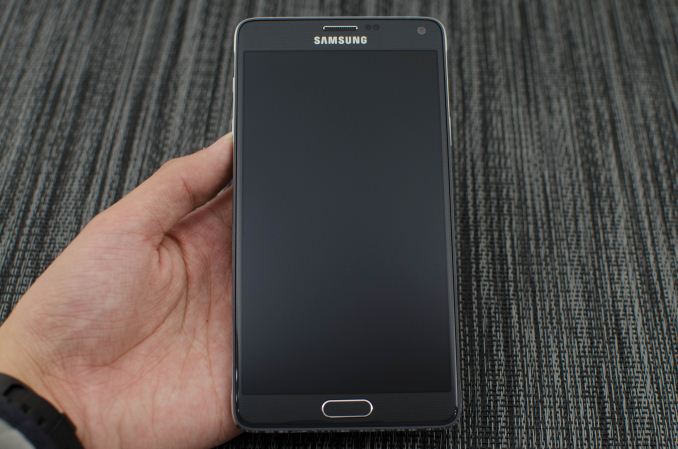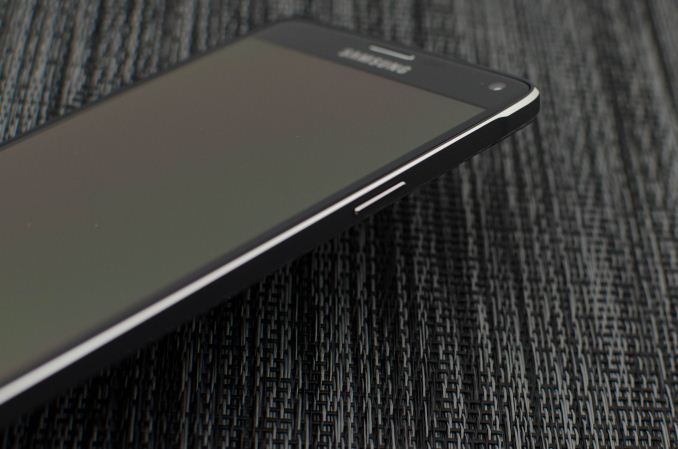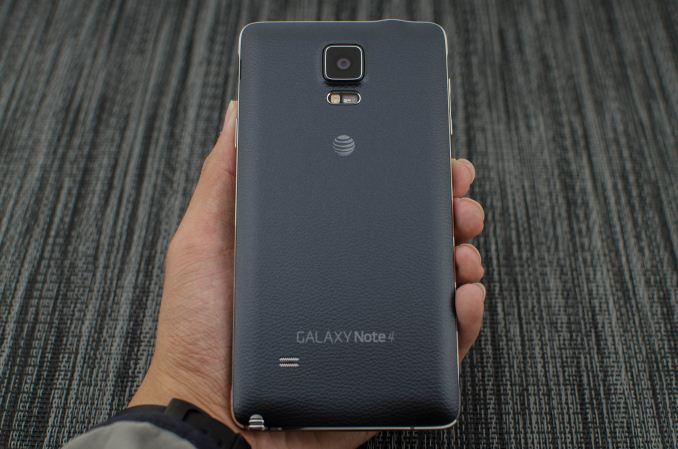The Samsung Galaxy Note 4 Review
by Joshua Ho on October 15, 2014 9:00 AM EST- Posted in
- Smartphones
- Samsung
- Android
- Mobile
- Galaxy Note 4

At this point, the Galaxy Note line needs little introduction. After all, the Galaxy Note is Samsung’s biggest success in mobile. While Apple redefined the smartphone and tablet segment, Samsung defined the phablet segment. Despite widespread skepticism, the original Galaxy Note was a massive success. Combined with the Galaxy S2, 2011 was a watershed year for Samsung as they leapfrogged other Android OEMs. Since then, we’ve seen continuous improvement from year to year with each Galaxy Note. While there were competitors, Samsung managed to hold on to their first-mover advantage for multiple generations. However, with the release of Apple’s iPhone 6 Plus we see one of the first significant threats to Samsung’s dominance of this segment.
The Galaxy Note 4 is Samsung’s latest iteration of the Galaxy Note phablet, and on the surface Samsung has put their best foot forward. With the highest bin of Qualcomm’s Snapdragon 805 or Exynos 5433, the latest generation AMOLED display, a 16MP camera with OIS, and a new design, the Galaxy Note 4 encompasses some of the best hardware that Samsung can deliver. I won’t spend too much time here, but the spec sheet below should cover most of the key points.
| Samsung Galaxy Note 3 | Samsung Galaxy Note 4 | |
| SoC | 2.26 GHz Snapdragon 800 | 2.7 GHz Snapdragon 805 |
| RAM/NAND | 3 GB LPDDR3, 32/64GB NAND + microSD | 3GB LPDDR3, 32GB NAND + microSD |
| Display | 5.7” 1080p Super AMOLED | 5.7” 1440p Super AMOLED |
| Network | 2G / 3G / 4G LTE (Qualcomm MDM9x25 IP block UE Category 4 LTE) | 2G / 3G / 4G LTE (Qualcomm MDM9x35 UE Category 6 LTE) |
| Dimensions | 151.2 x 79.2 x 8.3mm, 168 grams | 153.5 x 78.6 x 8.5 mm, 176 grams |
| Camera | 13MP Rear Facing, 1/3.06" CMOS size (Sony IMX135), 2.1MP FFC | 16MP Rear Facing w/ OIS, 1/2.6" CMOS size (Sony IMX240), F/2.0, 3.7MP FFC w/ F/1.9 aperture |
| Battery | 3200 mAh, 3.8V, 12.1 Whr | 3220 mAh, 3.85V, 12.397 Whr |
| OS | Android 4.4.2 with TouchWiz UX | Android 4.4.4 with TouchWiz UX |
| Connectivity | 802.11a/b/g/n/ac + BT 4.0, USB3.0, GPS/GNSS, MHL, DLNA, NFC | 802.11a/b/g/n/ac + BT 4.1, USB2.0, GPS/GNSS, MHL, DLNA, NFC |
| SIM Size | MicroSIM | MicroSIM |
While all of these things are easily discovered, the most immediate impressions always come from the design of the phone. In this respect, Samsung has done a surprisingly good job. On the front of the phone, we see a relatively standard design for Samsung. This entails a pattern on underneath the glass, which appears to be a bit shimmery in nature, along with dark black pinstripes. This causes a noticeable pattern in the capacitive buttons when lit, as with the LED notification light. There’s the standard earpiece and Samsung logo on top of the display, and a home button on the bottom, which serves as a fingerprint scanner as well. This home button is noticeably clicky in nature, and feels much better than the Galaxy Note 3’s home button.
On the sides, we see a similar level of improvement. The volume rocker, which is on the left side, and power button, which is on the right side, feel fantastic in comparison to most phones, and is quite close to the iPhone 6 and 6 Plus in feel. Unlike most Galaxy smartphones, we see an aluminum frame that runs all along the side of the phone, which also has a chamfered edge to eliminate sharp edges. In this area, Samsung has made serious strides as the frame really helps to make for a better in-hand feel that far exceeds what we saw with the Galaxy Note 3 or even the Galaxy S5. Along the top of the frame are cutouts for the 3.5mm headphone jack and IR port which enables TV remote functionality. Along the bottom of the frame, we see the microUSB 2.0 port. While this is technically a regression from the microUSB 3.0 port in speed and power delivery, I suspect compatibility issues and the ungainly design of the microUSB 3.0 standard justified a move back, at least until USB Type-C is ready for shipping devices.
On the back of the phone, we see some more changes. Instead of the downward-firing speakers of the Galaxy Note 3, we see that the speaker has been moved to the back of the phone. The design of the back cover is more an evolution of the Note 3’s back cover than the Galaxy S5’s, which has a noticeable faux leather pattern although the feel is closer to soft touch plastic. There’s also no stitching to try and make it seem more like leather. Instead, at the edges it seems to meet with the metal frame. A similar level of fit and finish is seen around the LED flash module, which is now flush with the back cover instead of sunk into the phone as with the Galaxy S5.
Overall, the design of the Galaxy Note 4 is massively improved. While it isn’t quite as amazing as the rounded design of the iPhone 6 and 6 Plus, it’s one of the best designs I’ve seen for a phone with a removable back cover. The only complaint I have is that Samsung should use a flat black pattern under the glass to accentuate the high contrast of the AMOLED display, but this is quite minor in nature.












195 Comments
View All Comments
akdj - Thursday, October 30, 2014 - link
Sorry. Something was lost in translation there;)I'm not going to go tbrough the dozen+ grammatical and punctuation errors, but my point was to compare iOS to Android with their siblings ...the Chromebook and OS X. Windows has the same if they're able to finally figure phones out! The SPIII is a HELLUVA design and enough difference between itself and the iPad (including the price, you're looking more like comparing a nice 13" rMBP w/Haswell ans Iris Pro graphics;))
Vertical and horizontal support. iOS and OS X with continuity and handoff being another extension of Airdrop is absolutely incredible!
The new near 15million pixel 5K iMac is a Grand Slam
iPad Air 2, it's A8X, a 2 and a ½ gen old 64 bit design---2GB of RAM, & a buck 28 built in with a half million 'optomized' tablet apps for everything from photo and video manipulation with Adobe, MS, & OS X integrated and aggregated alls to music creation, mixing and mastering ...magazines that are mind blowing, killer browser choices and unbelievably powerful video editing suites, drawing and sketching programs...old 'Chilton' fix 'em up guides or ForeFlight to file your F/P n tell ya how much gas you should pump in, while it considers diversions and real time weather and traffic. TCAS ans ADSB ...Jep charts, plates and updates in 'now' time, THAT'S a 'Tool!'
Farting around with ROMS is like rewiring your microwave. Why? It's to cook, melt, boil, or pop your F'ung popcorn!
tipoo - Wednesday, October 15, 2014 - link
Indeed. I'm excited for Nvidias Denver CPU cores, finally someone else going with two big cores rather than four small.mpokwsths - Wednesday, October 15, 2014 - link
Something is not right here..."Around 450 nits" with auto brightness on???
Displaymate strongly disagrees with Anandtech. They measured "478 - 750 cd/m2" with auto brightness (1 nit = 1 cd/m2)
http://www.displaymate.com/Galaxy_Note4_ShootOut_1...
melgross - Wednesday, October 15, 2014 - link
There is variability in production. The differences you are seeing are well within that variability.mpokwsths - Wednesday, October 15, 2014 - link
Don't be ridiculous, please...Displaymate: "When Automatic Brightness is turned On, the Galaxy Note 4 reaches an impressive 750 cd/m2 in High Ambient Light, where high Brightness is really needed – it is the brightest mobile display that we have ever tested"
It is an out-of-space claim that there can be a variability in production of a 70% level...
tralalalalalala40 - Saturday, October 18, 2014 - link
hopefully the display doesn't keep that brightness very long. those pentile pixels will burn out. you'll have to use a screen saver.theduckofdeath - Thursday, October 16, 2014 - link
Sounds like a poor excuse for inaccurate testing to me. If the error margin was that huge, the display would be horrible to look at.JoshHo - Wednesday, October 15, 2014 - link
In practice I find that the 100% APL value is more representative of the perceived brightness, this is due to a difference in testing methodology.Pissedoffyouth - Wednesday, October 15, 2014 - link
I just bought a note 3, and I'm more than happy with it with a zerolemon 10000mah battery. This doesn't really offer much more really, more of an slight upgrade.I'd be interested to see why they didn't up the battery a little more considering they made the chassis bigger...
darkich - Wednesday, October 15, 2014 - link
I find it impossible not to notice the Apple reality distortion effect in this article.But nice try hiding it, AT.
I'll just state a fact proven by pretty much every other review - battery endurance on this device is clearly better than that on the iPhone 6+.